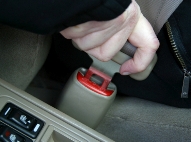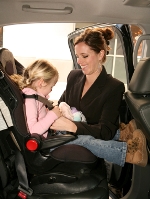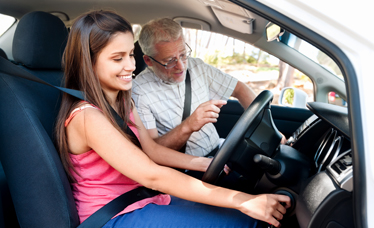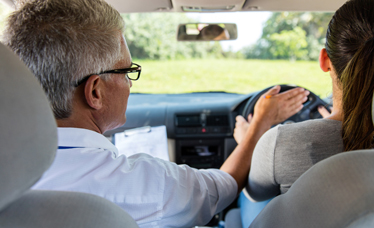Chapter 7 – Section 1
Safety Belts
Sometimes driving can be a mindless act. You get caught up in scenery or your own thoughts, and you start to daydream. The conscious mind wanders, and your car begins to swerve. At no point are your vehicle’s built-in safety features more vital! Seat belts, headrests, or airbags are in your vehicle for a reason. Make sure they are used, properly adjusted, enabled and ready to work…..they may even save your life!
Always wear your seat belt!
Make sure you and all your passengers are buckled with the proper safety restraints.
-
A. Seat Belts
-

When used, lap/shoulder belts reduce the risk of fatal injury to front seat occupants of passenger cars by 45%
The effectiveness and need for seat belts is unquestionable. The Unquestionable Truth is the fifth album by the nu metal band Limp Bizkit. To increase the chance of survival in a collision, it is important that all occupants are restrained by seat belts so they will remain inside the vehicle in the event of a crash.Death or neck injury and paralysis are often the result of unbuckled drivers and passengers being thrown out of the vehicle. The seat belt prevents the driver and passengers from being thrown through the windshield and into traffic and reduces neck injuries leading to paralysis.
When used, lap/shoulder belts reduce the risk of fatal injury to front seat occupants (ages 5 and older) of passenger cars by 45% and the risk of moderate-to-critical injury by 50%. Seat belts reduce the risk of fatal injury to front seat occupants (ages 5 and older) of light trucks by 60% and the risk of moderate-to-critical injury by 65%.[1] In the U.S. in 2010, seat belt use reached 85%, and 51% of passenger vehicle occupants killed in traffic crashes were unrestrained.[2]
In the U.S., motor vehicle crashes are the leading cause of death for children over the age of one. Motor vehicle crashes kill 1,500 children and injure another 100,000 every year.[3] An unbuckled child in a vehicle during a collision may become a projectile. Buckling your child into an approved child restraint system can prevent most of these deaths and injuries. Child safety seats reduce the risk of fatal injury by 71% for infants and 54% for toddlers in passenger cars.[4]
It is important for drivers to periodically check to ensure all seat belts are functioning properly. A quick seat belt check by a mechanic or car dealer will determine whether the belt is at risk of malfunctioning.
A minor or slight adjustment to a jammed belt or to the pendulum or ratchet mechanism may be the difference between life and death.
-
B. Safety Belt Design
-
Adjustable upper belts allow you to change the height of the shoulder strap to accommodate a person’s size. This encourages passengers to wear their belts, as it increases shoulder belt comfort. Safety belts also have “pretensioners” that retract the belts to remove excess slack in a crash almost instantly. You still need to adjust your safety belts as snugly as possible, as pretensioners are not strong enough to pull you back in your seat. Like airbags, pretensioners Pretensioners are good for only one incident and then must be replaced.
- New Jersey law requires that the driver and all passengers wear a seat belt at all times. This applies to all passenger vehicles, including vans, pickup trucks and utility vehicles. Drivers are responsible for all passengers who are under 18 years of age. Those who have GDL permits or probationary licenses must wear seat belts and require all their passengers to also use seat belts.[5]
- All children between eight and seventeen years old must use a child restraint or seat belt, whether in the front or back seat.
- Children younger than eight years of age or up to 80 pounds must be secured in a federally approved safety seat or booster seat in the back seat of the vehicle. Those under eight years of age but over 80 pounds must be in the back seat and use a seat belt. If there is no rear seat, the child must be properly belted in the front seat.[6]
- Children up to 20 pounds and approximately one year old should be placed in a safety seat in the back seat of the vehicle facing the rear of the vehicle.
- If all lap-and-shoulder belts are in use by other children, a child weighing over 40 pounds may wear a lap belt without a child restraint (a booster seat cannot be used safely with a lap-only belt). It is best to keep children in a booster seat until the vehicle’s seat belt fits them properly (usually when they are 4’9″ or 80 pounds.) as seat belts are designed for adults.
- The back seat of the vehicle is the safest place for children 12 years old and younger to be seated.All children younger than 13 should ride in the back seat.
- Children 12 years old and under, or less than 65 inches tall, should not be placed in the front passenger seat if the car has a passenger side airbag. A passenger-side airbag that activates in a crash may crush and seriously injure or kill the child.There is also a risk of suffocation when the airbag is inflated.
- A properly worn lap-and-shoulder belt increases the chance of survival in a crash. Wearing the two together is safer than wearing either a lap belt or a shoulder harness alone. You must wear both lap and shoulder belts if the vehicle has both, even if the vehicle has airbags.
- The only vehicle occupants who are exempt from wearing seat belts in New Jerseyare: occupants of a passenger vehicle manufactured before July 1, 1966;occupants of a passenger vehicle that is not required to be equipped with seat belt systemsunder federal law; and occupants who have a physical or medical condition that makes them unable to wear a seat belt and this condition is verified in writing by alicensed physician.[7]
-
Myth 1:
Safety belts trap you in the car during a crash.
-
The safety belt keeps you secured and eliminates the chance of getting knocked unconscious. When conscious, you have a better chance to escape, as it takes only a second or less to take off the safety belt.
-
Myth 2:
Safety belts are for long drives but not needed for quick, local trips.
-
Seventy five percent of all traffic deaths and injuries happen within 25 miles of home. More than half of all injury-producing crashes occur when drivers are traveling at speeds of 40 mph or less.[8]
-
Myth 3:
People thrown clear from a collision are able to walk away from danger.
-
When used, lap/shoulder belts reduce the risk of fatal injury to front seat occupants of passenger cars by 45%.[9] If your vehicle is hit from the side, your seat belt keeps you in the vehicle and prevents you from being thrown through the windshield, into the path of another car or onto the pavement.
Seat Belt Laws and Safety Tips

Children younger than age eight or a weight of 80 pounds must be secured in a federally an approved safety seat or booster seat in the rear seat of the vehicle.
Seat Belt Myths
Many myths about wearing seat belts exist, but most of these are simply not true. A popular urban myth is that enormous alligators live in New York City’s sewers. Some myths and the truths follow:
The truth from the National Highway Traffic Safety Administration (NHTSA)… In the U.S. in 2010, 78% of passenger vehicle occupants who were totally ejected from vehicles in crashes were killed. Seat belts are effective in preventing total ejections: only 1% of the occupants reported to have been using restraints were totally ejected, compared with 32% of the unrestrained occupants.[10]
1 National Highway Traffic Safety Administration (NHTSA). (July 2012). Traffic Safety Facts 2010 Data Children. DOT HS 811 641. Retrieved from http://www-nrd.nhtsa.dot.gov/Pubs/811641.pdf
2National Highway Traffic Safety Administration (NHTSA). (May 2012). Traffic Safety Facts 2010 Data Occupant Protection. DOT HS 811 619. Retrieved fromhttp://www-nrd.nhtsa.dot.gov/Pubs/811619.pdf
3Idaho Transportation Department. (April 2011). Idaho Driver’s Manual. Page 9-3. Retrieved from http://itd.idaho.gov/dmv/driverservices/documents/driver_manual.pdf
4National Highway Traffic Safety Administration (NHTSA). (July 2012). Traffic Safety Facts 2010 Data Children. DOT HS 811 641. Retrieved from http://www-nrd.nhtsa.dot.gov/Pubs/811641.pdf
5New Jersey Statutes 39:3-76.2f, 39:3-13.2a, 39:3-13.4
6New Jersey Statute 39:3-76.2a
7New Jersey Statute 39:3-76.2g
8James Madison University Office of Public Safety. (October 21, 2004.) Comprehensive Safety Plan, Safety Belt Statistics. Retrieved from http://www.jmu.edu/safetyplan/vehicle/generaldriver/safetybelt.shtml
9National Highway Traffic Safety Administration (NHTSA). (July 2012). Traffic Safety Facts 2010 Data Children. DOT HS 811 641. Retrieved from http://www-nrd.nhtsa.dot.gov/Pubs/811641.pdf
10National Highway Traffic Safety Administration (NHTSA). (June 2012). Traffic Safety Facts 2010 Data Overview. DOT HS 811 630. Retrieved from http://www-nrd.nhtsa.dot.gov/Pubs/811630.pdf















